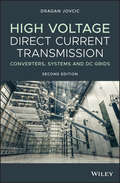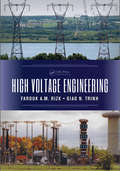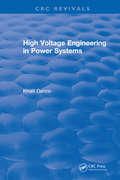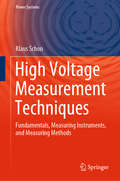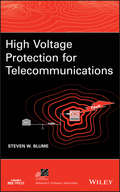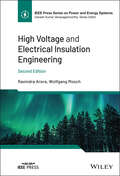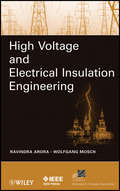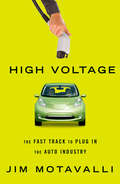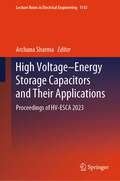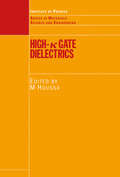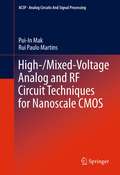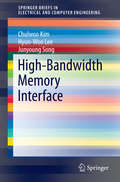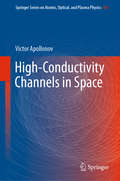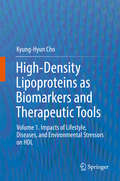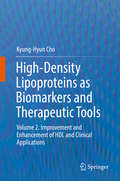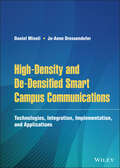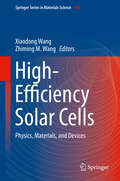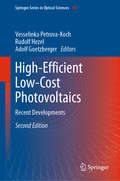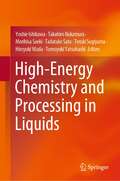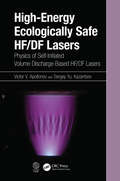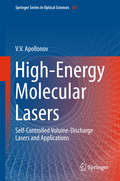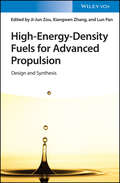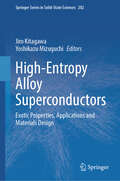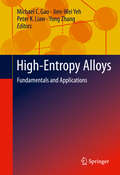- Table View
- List View
High Voltage Direct Current Transmission: Converters, Systems and DC Grids
by Dragan JovcicPresents the latest developments in switchgear and DC/DC converters for DC grids, and includes substantially expanded material on MMC HVDC This newly updated edition covers all HVDC transmission technologies including Line Commutated Converter (LCC) HVDC; Voltage Source Converter (VSC) HVDC, and the latest VSC HVDC based on Modular Multilevel Converters (MMC), as well as the principles of building DC transmission grids. Featuring new material throughout, High Voltage Direct Current Transmission: Converters, Systems and DC Grids, 2nd Edition offers several new chapters/sections including one on the newest MMC converters. It also provides extended coverage of switchgear, DC grid protection and DC/DC converters following the latest developments on the market and in research projects. All three HVDC technologies are studied in a wide range of topics, including: the basic converter operating principles; calculation of losses; system modelling, including dynamic modelling; system control; HVDC protection, including AC and DC fault studies; and integration with AC systems and fundamental frequency analysis. The text includes: A chapter dedicated to hybrid and mechanical DC circuit breakers Half bridge and full bridge MMC: modelling, control, start-up and fault management A chapter dedicated to unbalanced operation and control of MMC HVDC The advancement of protection methods for DC grids Wideband and high-order modeling of DC cables Novel treatment of topics not found in similar books, including SimPowerSystems models and examples for all HVDC topologies hosted by the 1st edition companion site. High Voltage Direct Current Transmission: Converters, Systems and DC Grids, 2nd Edition serves as an ideal textbook for a graduate-level course or a professional development course.
High Voltage Engineering
by Farouk A.M. Rizk Giao N. TrinhInspired by a new revival of worldwide interest in extra-high-voltage (EHV) and ultra-high-voltage (UHV) transmission, High Voltage Engineering merges the latest research with the extensive experience of the best in the field to deliver a comprehensive treatment of electrical insulation systems for the next generation of utility engineers and electric power professionals. The book offers extensive coverage of the physical basis of high-voltage engineering, from insulation stress and strength to lightning attachment and protection and beyond. Presenting information critical to the design, selection, testing, maintenance, and operation of a myriad of high-voltage power equipment, this must-have text: Discusses power system overvoltages, electric field calculation, and statistical analysis of ionization and breakdown phenomena essential for proper planning and interpretation of high-voltage tests Considers the breakdown of gases (SF6), liquids (insulating oil), solids, and composite materials, as well as the breakdown characteristics of long air gaps Describes insulation systems currently used in high-voltage engineering, including air insulation and insulators in overhead power transmission lines, gas-insulated substation (GIS) and cables, oil-paper insulation in power transformers, paper-oil insulation in high-voltage cables, and polymer insulation in cables Examines contemporary practices in insulation coordination in association with the International Electrotechnical Commission (IEC) definition and the latest standards Explores high-voltage testing and measuring techniques, from generation of test voltages to digital measuring methods With an emphasis on handling practical situations encountered in the operation of high-voltage power equipment, High Voltage Engineering provides readers with a detailed, real-world understanding of electrical insulation systems, including the various factors affecting—and the actual means of evaluating—insulation performance and their application in the establishment of technical specifications.
High Voltage Engineering in Power Systems
by Khalil DennoThis book supplements the comprehensive coverage of high voltage engineering with solved examples followed by a set of problems. It blends the areas of physics, engineering analysis and applications of high voltage engineering into a unified package suitable to the reader seeking physical and engineering understanding of this field.
High Voltage Measurement Techniques: Fundamentals, Measuring Instruments, and Measuring Methods (Power Systems)
by Klaus SchonThis book conveys the theoretical and experimental basics of a well-founded measurement technique in the areas of high DC, AC and surge voltages as well as the corresponding high currents. Additional chapters explain the acquisition of partial discharges and the electrical measured variables. Equipment exposed to very high voltages and currents is used for the transmission and distribution of electrical energy. They are therefore tested for reliability before commissioning using standardized and future test and measurement procedures. Therefore, the book also covers procedures for calibrating measurement systems and determining measurement uncertainties, and the current state of measurement technology with electro-optical and magneto-optical sensors is discussed.
High Voltage Protection for Telecommunications (IEEE Press Series on Power Engineering #44)
by Steven W. BlumeThere is growing concern that new engineers, planners, and field technicians are not aware of the danger and reliability issues surrounding proper protection of telecommunications circuits. Using a practical, hands-on approach, High Voltage Protection for Telecommunications combines all the essential information and key issues into one book. Designed for professional training and self-study, the text will help guide managers, engineers, planners, and technicians through the process of planning, designing, installing, and maintaining safe and reliable data and voice communications circuits that are exposed to High Voltage events.
High Voltage and Electrical Insulation Engineering (IEEE Press Series on Power and Energy Systems #69)
by Ravindra Arora Wolfgang MoschHigh Voltage and Electrical Insulation Engineering A comprehensive graduate-level textbook on high voltage insulation engineering, updated to reflect emerging trends and techniques in the field High Voltage and Electrical Insulation Engineering presents systematic coverage of the behavior of dielectric materials. This classic textbook opens with clear explanations of fundamental terminology, electric-field classification, and field estimation techniques. Subsequent chapters describe the field dependent performance of gaseous, vacuum, liquid, and solid dielectrics under different classified field conditions, and illustrate the monitoring of electrical insulation conditions by both single and continuous online methods. Throughout the text, numerous tables, figures, diagrams, and images are provided to strengthen understanding of all material. Fully revised to incorporate the most current technological application techniques, the second edition offers an entirely new section on condition monitoring of electrical insulation. Updated chapters discuss recent developments in gas-filled power apparatus, present-day trends in the use replacement of liquid insulating materials, the latest applications of new solid dielectrics in high voltage engineering, vacuum technology and liquid insulating materials, and more. This edition features a brand-new case study exploring the estimation of clearance requirements for 25 kV electric traction. Readers will also find the new edition: Provides new coverage of advances in the field, such as the application of polymer insulators and the use of SF6 gas and its mixtures in gas-insulated systems/substations (GIS) Uses a novel approach that explores the field dependent behavior of dielectrics Explains the “weakly nonuniform field,” a unique concept introduced both conceptually and analytically in Germany A separate chapter provides the new approach to the mechanism of lightning phenomenon, which also includes the phenomenon of “Ball Lightning” The dielectric properties of vacuum and the development in the application of vacuum technology in power circuit breakers is covered in an exclusive chapter In-depth coverage of the performance of the sulphur-hexafluoride gas and its mixtures applicable to the design of Gas Insulated Systems including dry power transformers High Voltage and Electrical Insulation Engineering, Second Edition, remains the perfect textbook for graduate students, teachers, academic researchers, and utility and power industry engineers and scientists involved in the field.</p.
High Voltage and Electrical Insulation Engineering, 1st Edition
by Ravindra Arora Wolfgang MoschThe book is written for students as well as for teachers and researchers in the field of High Voltage and Insulation Engineering. It is based on the advance level courses conducted at TU Dresden, Germany and Indian Institute of Technology Kanpur, India. The book has a novel approach describing the fundamental concept of field dependent behavior of dielectrics subjected to high voltage. There is no other book in the field of high voltage engineering following this new approach in describing the behavior of dielectrics.The contents begin with the description of fundamental terminology in the subject of high voltage engineering. It is followed by the classification of electric fields and the techniques of field estimation. Performance of gaseous, liquid and solid dielectrics under different field conditions is described in the subsequent chapters. Separate chapters on vacuum as insulation and the lightning phenomenon are included.
High Voltage: The Fast Track to Plug In the Auto Industry
by Jim MotavalliA behind-the-scenes look at the robustly competitive race to dominate the market for electric cars, the larger-than-life moguls behind them, and the changes that are transforming the auto industryIn the 1980s, it was unimaginable that the home computer would become as common and easy to use as a toaster. Today, plug-in charging stations and smart grids seem like something still far off in the future. But by 2020, the auto industry will look very different from today's field of troubled auto giants. The combination of technological breakthroughs and charging networks driven by global warming and peak oil makes it clear that revolutionary change in the auto industry is happening right now. In High Voltage, Jim Motavalli captures this period of unprecedented change, documenting the evolution from internal combustion engines to electric power. Driven by the auto world's ambitious and sometimes outlandish personalities, the book chronicles the race to dominate the market, focusing on big players like Tesla and Fisker, as well as a tiny start-up and a battery supplier. Flashing forward to the changes we'll see in the coming years, High Voltage shows a not-so-distant future where we will live on a smart grid, our cars "fueling," that is, charging, while we shop or sleep. The ramifications of these changes will be on a grander scale than most of us ever imagined—altering foreign policy, reducing trade deficits, and perhaps even ending global warming.
High Voltage–Energy Storage Capacitors and Their Applications: Proceedings of HV-ESCA 2023 (Lecture Notes in Electrical Engineering #1143)
by Archana SharmaThis book presents select proceedings of the conference on "High Voltage-Energy Storage Capacitors and Applications (HV-ESCA 2023)" that was jointly organized by Beam Technology Development Group (BTDG) and Electronics & Instrumentation Group (E&IG), BARC at DAE Convention Centre, Anushakti Nagar from 22nd to 24th June 2023. The book includes papers on topics, such as energy storage technologies (capacitor & battery), HV insulation & dielectric material, electromagnetic accelerators (rail and coil gun), electron beam accelerators, generation of fast rising voltage pulses, topologies & control schemes in power modules, pulsed nuclear radiation generators, electromagnetic welding, EMI & EMC, HV transmission lines, insulation material, and plasma generators. Papers included in this book impart better understanding of phenomena and intricacies of high voltage-energy storage capacitors and its applications to practicing engineers and researchers and update the latest information on interdisciplinary trending techniques. The book can be a valuable reference for beginners, researchers, and professionals interested in energy storage, pulsed power, and allied fields.
High k Gate Dielectrics
by Michel HoussaThe drive toward smaller and smaller electronic componentry has huge implications for the materials currently being used. As quantum mechanical effects begin to dominate, conventional materials will be unable to function at scales much smaller than those in current use. For this reason, new materials with higher electrical permittivity will be requ
High-/Mixed-Voltage Analog and RF Circuit Techniques for Nanoscale CMOS
by Pui-In Mak Rui Paulo MartinsThis book presents high-/mixed-voltage analog and radio frequency (RF) circuit techniques for developing low-cost multistandard wireless receivers in nm-length CMOS processes. Key benefits of high-/mixed-voltage RF and analog CMOS circuits are explained, state-of-the-art examples are studied, and circuit solutions before and after voltage-conscious design are compared. Three real design examples are included, which demonstrate the feasibility of high-/mixed-voltage circuit techniques. Provides a valuable summary and real case studies of the state-of-the-art in high-/mixed-voltage circuits and systems; Includes novel high-/mixed-voltage analog and RF circuit techniques - from concept to practice; Describes the first high-voltage-enabled mobile-TVRF front-end in 90nm CMOS and the first mixed-voltage full-band mobile-TV Receiver in 65nm CMOS;Demonstrates the feasibility of high-/mixed-voltage circuit techniques with real design examples.
High-Bandwidth Memory Interface
by Chulwoo Kim Junyoung Song Hyun-Woo LeeThis book provides an overview of recent advances in memory interface design at both the architecture and circuit levels. Coverage includes signal integrity and testing, TSV interface, high-speed serial interface including equalization, ODT, pre-emphasis, wide I/O interface including crosstalk, skew cancellation, and clock generation and distribution. Trends for further bandwidth enhancement are also covered.
High-Conductivity Channels in Space (Springer Series on Atomic, Optical, and Plasma Physics #103)
by Victor ApollonovThis book discusses the physics of conductive channel development in space, air and vacuums and summarizes the attempts to create super-long conductive channels to study the upper atmosphere and to complete specific tasks related to energy transmission from the space to earth with high-voltage high repetition rate electrical sources. Conductive channels are produced by the laser jet engine vehicle-propulsion under the influence of powerful high repetition rate pulse-periodic laser radiation by CO2-laser, solid state Nd YAG,HF/DF laser systems generated with each pulse of the powerful laser conductive dust plasma. The book also presents the experimental and theoretical results of conductive canal modeling: the laser jet engine vehicle “Impulsar”, which can reach the lower layers of the ionosphere in several hundred seconds. Further, the book explores the development of lightning protection systems. The so-called long laser spark is generated to provide the conditions for connecting a thunderstorm cloud with a grounded metal rod, i.e. a classical lightning rod. Such conductivity channels can be used for energy transmission, overvoltage protection systems, transport of charged particle beams and plasma antennas. It provides the theoretical and experimental basis of high repetition rate P-P mode of operation for high power lasers (COIL, HF/DF, CO2,Nd YAG). It describes high efficiency and excellent beam quality disk lasers used for numerous applications, including surface treatment of dielectric materials in microelectronics, cutting, drilling, welding, polishing and cleaning of the surface and other technological operations. Lastly it investigates how megawatt mono-module disk lasers could be used to solve various problems: small satellites launched by lasers, formation of super-long conducting channels in space and atmosphere, cleaning of the near-earth space from the space debris and related applications.
High-Density Lipoproteins as Biomarkers and Therapeutic Tools: Volume 1. Impacts of Lifestyle, Diseases, and Environmental Stressors on HDL
by Kyung-Hyun ChoThis book is the first of two volumes that offer a comprehensive, up-to-date account of current knowledge regarding high-density lipoprotein (HDL), the changes that occur in HDL under different conditions, the clinical applications of HDL, and means of enhancing HDL functionality. HDL comprises a diverse group of lipoproteins and its composition and metabolism are dynamic. In this volume, the focus is on the changes observed in HDL under different health statuses, with particular attention to the functional and structural correlations of HDL and apolipoprotein A-1. The impacts of a wide variety of factors on HDL are examined in depth, covering, for example, diet, exercise, smoking, age, diverse diseases, and different forms of environmental pollution. It has long been known that HDL has anti-atherosclerotic and antidiabetic properties, and more recently its anti-aging activities have been recognized. These benefits of HDL are highly dependent on its lipids, proteins, apolipoproteins, and enzymes, and specifically their composition and ratios. In documenting the latest knowledge in this field, this volume will be of interest to both researchers and clinicians.
High-Density Lipoproteins as Biomarkers and Therapeutic Tools: Volume 2. Improvement and Enhancement of HDL and Clinical Applications
by Kyung-Hyun ChoThis book is the second of two volumes that offer a comprehensive, up-to-date account of current knowledge regarding high-density lipoprotein (HDL), the changes that occur in HDL under different conditions, the clinical applications of HDL, and means of enhancing HDL functionality. In this volume, the focus is on the improvement of HDL, enhancement of its functionality, and the use of HDL for therapeutic purposes. In the first section, up-to-date information is provided on such topics as the tumor regression-promoting and antidiabetic activities of reconstituted HDL containing V156K apolipoprotein A-I, the enhancement of HDL effects by high doses of vitamin C, the benefits derived from incorporation of growth hormones 1 and 2 into rHDL, and the biological functions of omega-3 linolenic acid in rHDL. The enhancement of HDL functionality by policosanol and the resultant benefits are thoroughly examined in a separate section. Readers will also find the latest information on clinical applications of HDL. Here, specific topics include the enhancement of adenoviral gene delivery and the delivery of rapamycin. In documenting the latest knowledge in this field, this volume will be of interest to both researchers and clinicians.
High-Density and De-Densified Smart Campus Communications: Technologies, Integration, Implementation and Applications
by Daniel Minoli Jo-Anne DressendoferDiscover how to design, deliver, and implement high-density communications solutions High-Density Smart Campus Communications: Technologies, Integration, Implementation and Applications delivers a concise synthesis of the deployment technologies, strategies, and implementation issues that arise in the design and application of real-world high-density communications environments in airports, stadiums, convention centers, shopping malls, classrooms, hospitals, cruise ships, and more. You'll learn future-oriented strategies for the implementation of next-generation Wi-Fi and 5G communications networks in high density environments, like smart airposrts, advanced airport robotics, and wayfinding. You’ll also discover effective deployment strategies using a comprehensive case study based on a top-10 airport deployment by the Slice Wireless team. The book includes information about security requirements, large and boutique solution providers, applications, unbundled services, implementation planning and design, as well as operations and network management. An epilogue written by Josie Jo-Anne Dressendofer of Slice Wireless concludes the text. Readers will also benefit from the inclusion of: A thorough introduction to background and functional requirements for high density communications, including requirements for airports, stadiums, convention centers, classrooms, train and subway stations, and smart cities An exploration of traditional voice and cellular technology, including DAS designs and architectures and microcellularization Practical discussions of traditional data and Wi-Fi, including throughput/interference and security A treatment of evolved hotspot connectivity, including Wi-Fi and 5G Perfect for telecommunication researchers and engineers, networking professionals, technology professionals, campus administrators, and equipment vendors, High-Density Smart Campus Communications will also earn a place in the libraries of senior undergraduate and graduate students in applied communications technologies.
High-Efficiency Solar Cells
by Xiaodong Wang Zhiming M. WangAs part of the effort to increase the contribution of solar cells (photovoltaics) to our energy mix, this book addresses three main areas: making existing technology cheaper, promoting advanced technologies based on new architectural designs, and developing new materials to serve as light absorbers. Leading scientists throughout the world create a fundamental platform for knowledge sharing that combines the physics, materials, and device architectures of high-efficiency solar cells. While providing a comprehensive introduction to the field, the book highlights directions for further research, and is intended to stimulate readers' interest in the development of novel materials and technologies for solar energy applications.
High-Efficient Low-Cost Photovoltaics: Recent Developments (Springer Series in Optical Sciences #140)
by Vesselinka Petrova-Koch Rudolf Hezel Adolf GoetzbergerThis book offers a bird’s-eye view of the recent development trends in photovoltaics – a big business field that is rapidly growing and well on its way to maturity. The book describes current efforts to develop highly efficient, low-cost photovoltaic devices based on crystalline silicon, III–V compounds, copper indium gallium selenide (CIGS) and perovskite photovoltaic cells along with innovative, cost-competitive glass/ flexible tubular glass concentrator modules and systems, highlighting recent attempts to develop highly efficient, low-cost, flexible photovoltaic cells based on CIGS and perovskite thin films. This second edition presents, for the first time, the possible applications of perovskite modules together with Augsburger Tubular photovoltaics.
High-Energy Charged Particles
by Shu Seki Tsuneaki Sakurai Masaaki Omichi Akinori Saeki Daisuke SakamakiThis book features comprehensive explanations from the classical theory of high-energy particle interactions with matter to their use for a novel nanofabrication technique for various organic soft materials. Potential readers include scientists and engineers in both academia and industry, as well as students of materials science, nanotechnology, and nuclear power engineering. Readers will learn about the historical research background of radiation chemistry and interactions of an accelerated particle with matter, and then move on to recent research topics having to do with nanofabrication of soft materials by using single charged particles with high energy. Target materials of the highlighted novel technique include proteins, thermo-responsive and photo-responsive polymers, semiconducting polymers, and even small organic molecules. The descriptions of these various newly developed nanomaterials will interest a broad spectrum of readers and provide them with a new perspective. The many conceptual illustrations and microscopic images of nanomaterials that are included will help readers to easily understand the contents of the book.
High-Energy Chemistry and Processing in Liquids
by Yoshie Ishikawa Takahiro Nakamura Morihisa Saeki Tadatake Sato Teruki Sugiyama Hiroyuki Wada Tomoyuki YatsuhashiThis book focuses on chemical reactions and processing under extreme conditions—how materials react with highly concentrated active species and/or in a very confined high-temperature and high-pressure volume. Those ultimate reaction environments created by a focused laser beam, discharges, ion bombardments, or microwaves provide characteristic nano- and submicron-sized products and functional nanostructures. The book explores the chemistry and processing of metals and non-metals as well as molecules that are strongly dependent on the energy deposition processes and character of the materials. Descriptions of a wide range of topics are given from the perspective of a variety of research methodologies, material preparations, and applications. The reader is led to consider and review how a high-energy source interacts with materials, and what the key factors are that determine the quality and quantity of nanoproducts and nano-processing.
High-Energy Ecologically Safe HF/DF Lasers: Physics of Self-Initiated Volume Discharge-Based HF/DF Lasers
by Victor V. Apollonov Sergey Yu. KazantsevThis book explores new principles of Self-Initiating Volume Discharge for creating high-energy non-chain HF(DF) lasers, as well as the creation of highly efficient lasers with output energy and radiation power in the spectral region of 2.6–5 μm. Today, sources of high-power lasing in this spectral region are in demand in various fields of science and technology including remote sensing of the atmosphere, medicine, biological imaging, precision machining and other special applications. These applications require efficient laser sources with high pulse energy, pulsed and average power, which makes the development of physical fundamentals of high-power laser creation and laser complexes of crucial importance. High-Energy Ecologically Safe HF/DF Lasers: Physics of Self-Initiated Volume Discharge-Based HF/DF Lasers examines the conditions of formation of SSVD, gas composition and the mode of energy input into the gas on the efficiency and radiation energy of non-chain HF(DF) lasers. Key Features: Shares research results on SSVD in mixtures of non-chain HF(DF) lasers Studies the stability and dynamics of the development of SSVD Discusses the effect of the gas composition and geometry of the discharge gap (DG) on its characteristics Proposes recommendations for gas composition and for the method of obtaining SSVD in non-chain HF(DF) lasers Develops simple and reliable wide-aperture non-chain HF(DF) lasers and investigates their characteristics Investigates the possibilities of expanding the lasing spectrum of non-chain HF(DF) lasers
High-Energy Molecular Lasers
by V. V. ApollonovThis book displays the physics and design of high-power molecular lasers. The lasers described are self-controlled volume-discharge lasers. The book explains self-sustained discharge lasers, self-initiated discharge lasers and technical approaches to laser design. Important topics discussed are laser efficiency, laser beam quality and electric field homogeneity. The book contains many new innovative applications.
High-Energy-Density Fuels for Advanced Propulsion: Design and Synthesis
by Ji-Jun Zou Xiangwen Zhang Lun PanCovers the theory and practice of designing, synthesizing, and improving the performance of fuels This book provides readers with the fundamentals on high-energy-density fuels and their potential in advanced aerospace propulsion. It comprehensively and systematically demonstrates both the theory and practice of creating, processing, and refining the performance of fuels, all while connecting the past, present, and future of fuel chemistry and technology. It covers a wide range of fuels including polycyoalkane fuels, strained fuels, alky-diamondoid fuels, and hypergolic and nanofluid fuels derived from fossil and biomass. It also describes the important aspects of high-energy-density (HED) fuels, including molecular design, synthesis route, physiochemical properties, and their application in improving aircraft performance. In addition, the book features vivid schematics and illustrations throughout to enhance accessibility to the relevant theory and technologies. High-Energy-Density Fuels for Advanced Propulsion begins by introducing readers to the topic before delving into the development history and basics of aerospace fuels. It discusses the general properties and requirements of aerospace fuels, as well as the overall development. The book also covers the design and synthesis of green hypergolic liquid fuels, the formulation and synthesis of gelled fuels, the combustion properties of fuels and the methods for improving them, and more. A much-needed, complete overview of an important topic on fuel chemistry and technology for a range of fuels, including aerospace propulsion technology Provides readers with inspirations for new development of advanced aerospace fuels Discusses how HED fuels can improve the performance of aircraft Offers chapters covering fuels such as polycyoalkane, strained, alky-diamondoid, hypergolic, and nanofluid fuels High-Energy-Density Fuels for Advanced Propulsion is an excellent resource for those working in the fields of fuel chemistry, fuel technology, and aerospace propulsion technology, and is an ideal reference book for researchers, engineers, and students majoring in chemical science and engineering, mechanical engineering, and aerospace engineering.
High-Entropy Alloy Superconductors: Exotic Properties, Applications and Materials Design (Springer Series in Solid-State Sciences #202)
by Jiro Kitagawa Yoshikazu MizuguchiThis book offers a comprehensive survey of the latest research concerning high-entropy alloy (HEA) superconductors, an emerging topic which has attracted significant attention since their discovery in 2014. HEAs represent a novel class of materials introduced in 2004, renowned for their exceptional mechanical attributes, robust resistance to corrosion, and remarkable thermal stability, among other characteristics. Superconductivity has emerged as a particularly prominent subject in this domain. Recent important findings are robust superconductivity under extraordinarily high pressure or ion irradiation, possible unconventional superconductivity, enhancement of bulk superconductivity, and high critical current density. In this book, HEA superconductors are classified into two primary categories: The first class encompasses alloy systems characterized by body-centered cubic and hexagonal close-packed structures; and the second class comprises intermetallic types. In each of these classes, the authors expound upon the exotic properties, applications, and materials design, aligning with the overarching themes of their work. This book delivers a topical and timely discussion of superconductivity associated with the high-entropy state, the potential applications under consideration, and the intricacies of materials design. These recent discoveries are poised to captivate many researchers in materials science, particularly those engaged in high-entropy alloys and the realm of superconducting properties and technology.
High-Entropy Alloys
by Peter K. Liaw Michael C. Gao Jien-Wei Yeh Yong ZhangThis book provides a systematic and comprehensive description of high-entropy alloys (HEAs). The authors summarize key properties of HEAs from the perspective of both fundamental understanding and applications, which are supported by in-depth analyses. The book also contains computational modeling in tackling HEAs, which help elucidate the formation mechanisms and properties of HEAs from various length and time scales.
